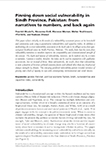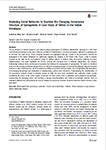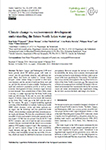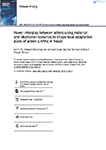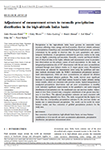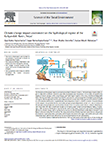Pinning Down Social Vulnerability in Sindh Province, Pakistan: From Narratives to Numbers, and Back Again
Peer Reviewed Journal Article, 2018
This paper reflects critically on the results of a vulnerability assessment process at the household and community scale using a quantitative vulnerabilities and capacities index. It validates a methodology for a social vulnerability assessment at the local scale in 62 villages across four agro‐ecological/livelihood zones in Sindh Province, Pakistan. The study finds that the move from vulnerability narratives to numbers improves the comparability and communicational strength of the concept.
Analyzing Social Networks to Examine the Changing Governance Structure of Springsheds: A Case Study of Sikkim in the Indian Himalayas
Peer Reviewed Journal Article, 2018
The governance of natural resources now attracts greater participation of different stakeholders, ushering in a shift from conventional governance by the state to that by a network of stakeholders—a form of governance marked by a growing role of non-state and local actors. These changing dynamics are highlighted through a study of the governance network for springsheds in the Indian Himalayas by empirically mapping the changes in the Dhara Vikas Yojna, a plan or scheme (yojana) by the state for the development (vikas) of springs (dhara) in Sikkim, India, from policy planning to policy implementation.
Climate Change vs. Socio-economic Development: Understanding the future South Asian water gap
Peer Reviewed Journal Article, 2018
The Indus, Ganges, and Brahmaputra (IGB) river basins provide about 900 million people with water resources used for agricultural, domestic, and industrial purposes. These river basins are marked as “climate change hotspots”, where climate change is expected to affect monsoon dynamics and the amount of meltwater from snow and ice, and thus the amount of water available. Simultaneously, rapid and continuous population growth as well as strong economic development will likely result in a rapid increase in water demand.
South Asian River Basins in a 1.5 °C Warmer World
Peer Reviewed Journal Article, 2018
In 2015, with the signing of the “Paris Agreement”, 195 countries committed to limiting the increase in global temperature to less than 2 °C with respect to pre-industrial levels and to aim at limiting the increase to 1.5 °C by 2100. The regional ramifications of those thresholds remain however largely unknown and variability in the magnitude of change and the associated impacts are yet to be quantified.
Evolving High Altitude Livelihoods and Climate Change: A Study from Rasuwa District, Nepal
Peer Reviewed Journal Article, 2018
This study examined local people’s perception of climate change and its impacts on their livelihoods, and identified key opportunities and threats arising in four Village Development Committees in the high mountains of Rasuwa District, Nepal. The local people are still heavily dependent on agriculture and livestock for their food security and livelihoods, despite the involvement of a significant proportion of households in non-agricultural income-generating activities, such as tourist services and labour work in other areas (outmigration).
Power Interplay Between Actors: Using Material and Ideational Resources to Shape Local Adaptation Plans of Action (LAPAs) in Nepal
Peer Reviewed Journal Article, 2018
Deliberation over how to adapt to short or long-term impacts of climate change takes place in a complex political setting, where actors’ interests and priorities shape the temporal dimension of adaptation plans, policies and actions. As actors interact to pursue their individual or collective interests, these struggles turn into dynamic power interplay. In this article, we aim to show how power interplay shapes local adaptation plans of action (LAPAs) in Nepal to be short-term and reactive.
Gendered Vulnerabilities in Diaras: Struggling with Floods in the Gandak River Basin
Peer Reviewed Journal Article, 2018
People living in diara villages within the embankments of the River Gandak in Bihar face high levels of vulnerability due to frequent flooding and droughts. Using anthropological surveys, gendered vulnerabilities in four diara villages in West Champaran are explored.
Adjustment of Measurement Errors to Reconcile Precipitation Distribution in the High-altitude Indus Basin
Peer Reviewed Journal Article, 2018
Precipitation in the high-altitude Indus basin governs its renewable water resources affecting water, energy and food securities. However, reliable estimates of precipitation climatology and associated hydrological implications are seriously constrained by the quality of observed data. As such, quantitative and spatiotemporal distributions of precipitation estimated by previous studies in the study area are highly contrasting and uncertain.
When do Indians feel hot? – internet searches indicate seasonality suppresses adaptation to heat
Peer Reviewed Journal Article, 2018
In a warming world an increasing number of people are being exposed to heat, making a comfortable thermal environment an important need. This study explores the potential of using Regional Internet Search Frequencies (RISF) for air conditioning devices as an indicator for thermal discomfort.
Climate change impact assessment on the hydrological regime of the Kaligandaki Basin, Nepal
Peer Reviewed Journal Article, 2018
The Hindu Kush-Himalayan region is an important global freshwater resource. The hydrological regime of the region is vulnerable to climatic variations, especially precipitation and temperature. In our study, we modelled the impact of climate change on the water balance and hydrological regime of the snow dominated Kaligandaki Basin.

